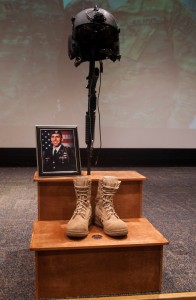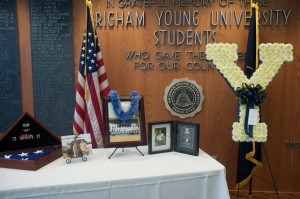
Inside the Wilkinson Center, just across from the Garden Terrace, lies an area of peace and great reverence.
Memorial Hall pays tribute to fallen soldiers from BYU. It starts with soldiers who died in World War I and continues to present-day wars. Inside the hall, names of soldiers who have died in combat are displayed on plaques, organized by the war in which they fought.
BYU professor Earl T. Pardoe and students who had served in World War II originated the idea for a student memorial center according to a brochure from the1983 rededication in the L. Tom Perry Special Collections. Donations provided by these students and Pardoe funded the memorial’s construction.
Originally called the Memorial Lounge, the Hall was dedicated in 1967, according to Gordon Daines, the former University Archivist.
“It was a fairly tumultuous, turbulent time. War was on people’s minds,” Daines said.
The intention of Memorial Hall is for visitors to pay respect to those who have died in war.
“It was meant to be a place of quiet reflection to remember those who had lost their lives in the service of our country,” Daines said.
A brochure from the rededication in 1983 also states the purpose of the memorial:
“They meant it to be a center of patriotic gatherings, an area where service medals, citations and individual honors could be displayed.”
Memorial Hall has been moved as additions and renovations have been made to the Wilkinson Student Center, according to Daines.
The Hall goes through a meticulous process to add names of soldiers who have died in combat. The process begins with either a request from the family of the fallen soldier or a request from the BYU ROTC department, according to Chad Brimley, the current general manager of the Wilkinson Center Support Services.

Brimley is in charge of maintaining Memorial Hall and adds the names to the plaques after requests have been approved. The military must verify that the fallen soldier was either a current BYU student or a graduate from BYU, according to Brimley. Along with this verification, there is one more important detail required for a name to be added onto a plaque:
“The military has to verify they actually died in war,” Brimley said.
Names of both soldiers and wars are being added to the hall regularly. Laura Leseberg, department secretary for the Air Force ROTC at BYU, participated in the addition of names while working as an office assistant for the Army ROTC. One name was added to Memorial Hall during that time: Nathan White.
“Nathan White was a lieutenant in the U.S. Navy,” Leseberg said. “He was killed in action April 2, 2003, over Iraq. He was flying a plane, and he was shot down. It was right at the very beginning of the war.”
Not only are names of soldiers added to the Hall, but names of wars as they continue to emerge become added to the Hall as well, as recognized by Brimley.
“We’ve had to add new conflicts; there are different names of the actual conflicts,” Brimley said. “The most recent one we have down there is Operation: Enduring Freedom, where we added one name of a soldier.”
The family of the fallen soldier featured in Operation: Enduring Freedom provided the plaque and two pictures: one of the soldier and one of the soldier and his squadron, according to Brimley.
After names have been approved by the ROTC, Wilkinson Center Support Services adds the name to a plaque and adds it to the wall of fallen soldiers.
“Really, all we do after we’re given the request is give the name of the conflict — if it’s not already up there — and then the name of the soldier,” Brimley said. “And then the ROTC holds a veil over the soldier’s name and then removes it. They have a special ceremony that they do to present the names.”
Even if no new names have been added that year, a special cermony is held annually to honor all of the soldiers in Memorial Hall, according to Brimley.
“Every Veteran’s Day they do a wreath-laying ceremony in there also. There’s usually a dignitary from BYU or the church that’s present there,” Brimley said. “Two years ago, President Uchtdorf came and was involved with the wreath-laying ceremony.”
Memorial Hall is treated with the same respect as a cemetery when it comes to honoring loved ones who have died.
“Sometimes family members of the fallen soldiers — just like in a graveyard — will bring in flowers or some type of arrangement and put it below some of the names,” Brimley said. “And we’ll leave it there for a brief amount of time.”
The purpose of Memorial Hall is to honor and remember the names of fallen soldiers who sacrificed their lives for their country. In the brochure made for the rededication of Memorial Hall in 1983, there is a quote that provides more insight on this mission:
“It is a challenge to the living to perpetuate these ideals that they will not have sacrificed in vain.”
Memorial Hall is welcome to all BYU students and all visitors of BYU campus to honor and remember those who have died in the preservation of freedom.




